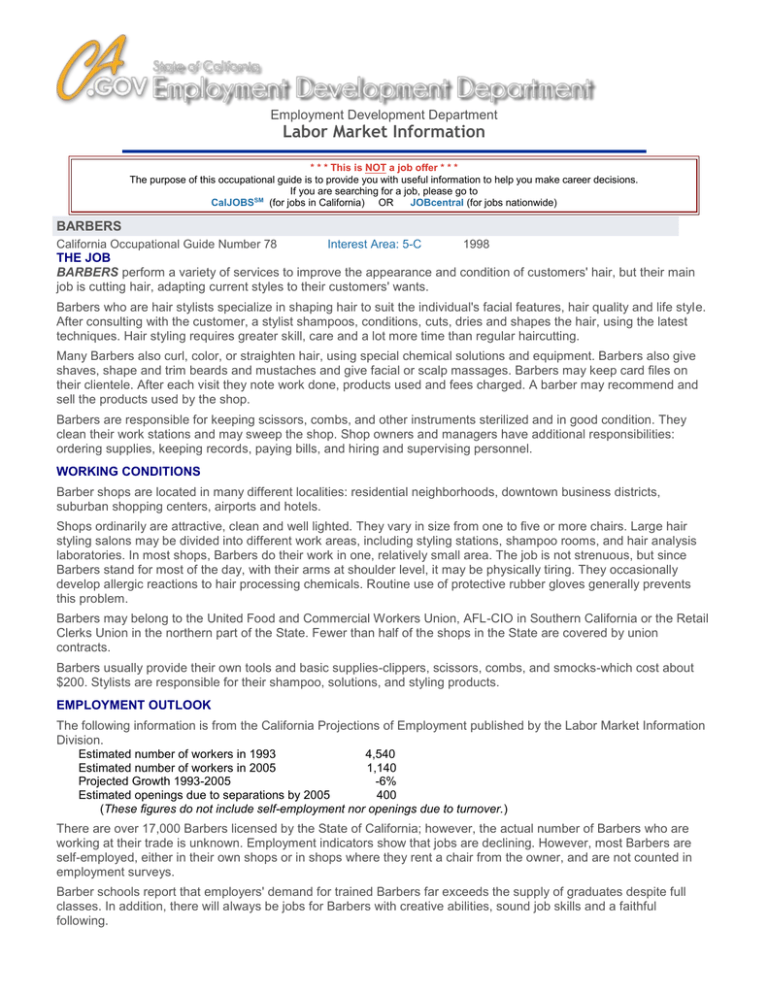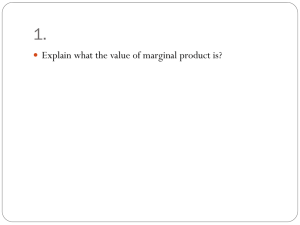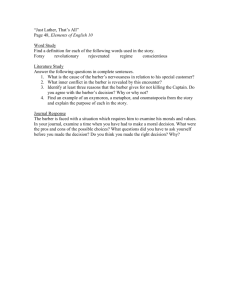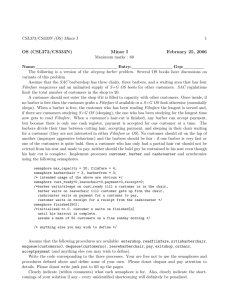edd occupational guide barber
advertisement

Employment Development Department Labor Market Information * * * This is NOT a job offer * * * The purpose of this occupational guide is to provide you with useful information to help you make career decisions. If you are searching for a job, please go to CalJOBSSM (for jobs in California) OR JOBcentral (for jobs nationwide) BARBERS California Occupational Guide Number 78 Interest Area: 5-C 1998 THE JOB BARBERS perform a variety of services to improve the appearance and condition of customers' hair, but their main job is cutting hair, adapting current styles to their customers' wants. Barbers who are hair stylists specialize in shaping hair to suit the individual's facial features, hair quality and life style. After consulting with the customer, a stylist shampoos, conditions, cuts, dries and shapes the hair, using the latest techniques. Hair styling requires greater skill, care and a lot more time than regular haircutting. Many Barbers also curl, color, or straighten hair, using special chemical solutions and equipment. Barbers also give shaves, shape and trim beards and mustaches and give facial or scalp massages. Barbers may keep card files on their clientele. After each visit they note work done, products used and fees charged. A barber may recommend and sell the products used by the shop. Barbers are responsible for keeping scissors, combs, and other instruments sterilized and in good condition. They clean their work stations and may sweep the shop. Shop owners and managers have additional responsibilities: ordering supplies, keeping records, paying bills, and hiring and supervising personnel. WORKING CONDITIONS Barber shops are located in many different localities: residential neighborhoods, downtown business districts, suburban shopping centers, airports and hotels. Shops ordinarily are attractive, clean and well lighted. They vary in size from one to five or more chairs. Large hair styling salons may be divided into different work areas, including styling stations, shampoo rooms, and hair analysis laboratories. In most shops, Barbers do their work in one, relatively small area. The job is not strenuous, but since Barbers stand for most of the day, with their arms at shoulder level, it may be physically tiring. They occasionally develop allergic reactions to hair processing chemicals. Routine use of protective rubber gloves generally prevents this problem. Barbers may belong to the United Food and Commercial Workers Union, AFL-CIO in Southern California or the Retail Clerks Union in the northern part of the State. Fewer than half of the shops in the State are covered by union contracts. Barbers usually provide their own tools and basic supplies-clippers, scissors, combs, and smocks-which cost about $200. Stylists are responsible for their shampoo, solutions, and styling products. EMPLOYMENT OUTLOOK The following information is from the California Projections of Employment published by the Labor Market Information Division. Estimated number of workers in 1993 4,540 Estimated number of workers in 2005 1,140 Projected Growth 1993-2005 -6% Estimated openings due to separations by 2005 400 (These figures do not include self-employment nor openings due to turnover.) There are over 17,000 Barbers licensed by the State of California; however, the actual number of Barbers who are working at their trade is unknown. Employment indicators show that jobs are declining. However, most Barbers are self-employed, either in their own shops or in shops where they rent a chair from the owner, and are not counted in employment surveys. Barber schools report that employers' demand for trained Barbers far exceeds the supply of graduates despite full classes. In addition, there will always be jobs for Barbers with creative abilities, sound job skills and a faithful following. WAGES, HOURS, AND FRINGE BENEFITS Barbers generally earn either a commission or a set fee for each service performed or a guaranteed weekly wage, whichever is higher. Commissions range from 40 percent to 80 percent of the gross earnings of the station at which the Barber works. Typical hourly earnings for beginners start at minimum wage, but the median wage for Barbers in California is $5.45 per hour. Earnings usually depend on the size, type and location of the shop. With experience, Barbers are capable of earning up to $20.00 or more an hour. Barbers may receive a commission on products they sell, and most of them receive tips. State law requires that overtime be paid at time and a half or double time. Fringe benefits are minimal; very few Barbers receive benefits such as paid vacations or medical insurance. The basic workweek for Barbers is 40 hours, usually including evenings or weekends. Days and hours vary with different shops or salons, depending upon location and clientele. ENTRANCE REQUIREMENTS AND TRAINING Barbers practicing in California must be licensed by the State Board of Barbering and Cosmetology. Those being examined must be at least 17 years old, have a ninth grade (or equivalent) education and complete an approved barber course. Graduates take a written, oral and practical examination in all aspects of barbering, including styling. The second way to qualify for a license is through a two-year apprenticeship program sponsored by the Joint Apprenticeship Training Committees (JATC). The program includes classroom instruction and full-time, paid on-thejob training. Apprentices work under the close supervision of a licensed Barber in a licensed shop. At the end of two years, they are eligible to take the State Board exam. Apprenticeships are available in many metropolitan areas through the California Department of Industrial Relations, Division of Apprenticeship Standards. ADVANCEMENT In some areas, the JATC, barber colleges or manufacturers sponsor advanced courses for registered Barbers wanting to improve their skills. Some experienced Barbers become shop managers or operate their own shops. A few complete the additional requirements to become licensed as barber college instructors. Others get jobs with manufacturers of barber products, demonstrating new styles and techniques. FINDING THE JOB Job seekers should ask for leads from their college, since employers often contact schools when openings are available. Some employers may visit schools to watch students work on customers' hair before they hire. Job seekers should apply directly to shops, contact their union and register with the California Employment Development Department Job Services. Jobs are also listed in newspaper help wanted ads. Some employers, particularly in large shops, do not need to actively recruit. They interview job seekers who apply in person and contact those who qualify when suitable openings occur. ADDITIONAL SOURCES OF INFORMATION For information about job opportunities as reservation and transportation ticket agents, write to individual airline companies. Addresses are available from: California State Board of Barbering and Cosmetology Examiners 400 R Street, Suite 4080, Sacramento, CA 95814, (916) 445-7061, http://www.dca.ca.gov/ California Department of Industrial Relations (Division of Apprenticeship Standards) 2424 Arden Way, Suite 160, Sacramento, CA 95825, (916) 263-2877 http://www.dir.ca.gov/das/das.html California Barber College Association 2645 El Camino Avenue, Sacramento, CA 95821, (916) 482-0871 RELATED OCCUPATIONAL GUIDES Cosmetologists No. 58 OCCUPATIONAL CODE REFERENCES DOT (Dictionary of Occupational Titles, 4th Ed. 1991) Barber 330.371-010 Barber Apprentice 330.371-014 (Occupational Employment Statistics) System Barbers 680020 Source: State of California Employment Development Department (Labor Market Information Division Information Services Group) (916) 262-2162. Note: This is NOT a job opening. The purpose of This California Occupational Guide is to provide you with useful information to help you make career decisions. If you are searching for a job, go to: CalJOBSSM (for jobs in California) JOBcentral (for jobs nationwide) The Employment Development Department is an equal opportunity employer/program. Auxiliary aids and services are available upon request to individuals with disabilities. Copyright © 2014 State of California BARBERING AND COSMETOLOGY INDUSTRY The purpose of this information sheet is to provide the barbering and cosmetology industry with standards to be used when applying the common law rules of employment specifically to a professional licensed by the Department of Consumer Affairs, Board of Barbering and Cosmetology. This information is intended to clarify those circumstances under which this individual is an employee or independent contractor. What is a Licensed Professional? A “licensed professional” is an individual licensed by the Department of Consumer Affairs and includes, but is not limited to, barbers, cosmetologists, manicurists, electrologists, and estheticians. What is a Principal? A “principal” is defi ned as a cosmetology business operator or salon owner, or his or her agent or manager. The types of businesses in which the licensed professionals provide services include, but are not limited to: - Barber Colleges - Facial Salons - Barber Shops - Hairdressers - Beauty and Barber Shops - Hair Stylists, Men Combined - Hair Stylists, Women - Beauty Culture Schools - Manicure/Pedicure - Beauty Shops or Salons Shops - Clinics for Skin Care - Spas - Cosmetology Schools - Unisex Hairdressers - Cosmetology Shops or Salons Employee or Independent Contractor? Section 4304-1 of Title 22, California Code of Regulations (CCR), provides that to determine whether one performs services for another as an employee, the most important factor is the right of the principal to control the manner and means of accomplishing a desired result. Section 4304-12 of Title 22, CCR, provides standards to be used when applying the common law rules specifically to a professional licensed by the Board of Barbering and Cosmetology and is intended to make clearer those circumstances under which this individual is an employee or independent contractor. Licensed Professional Determination Elements The following Table of Determination Elements – Barbering and Cosmetology as provided in Section 430412 of Title 22, CCR, provides determination elements which shall be considered to determine whether a licensed professional is an employee or independent contractor with an explanation of the weight given to each element. Not all of the elements listed in the table need to be present to make a determination that a particular employee or independent contractor relationship exits. A determination of whether the services are being performed as an employee or independent contractor will depend upon a grouping of the elements present that are significant in relationship to the services being performed. RULING REQUEST A formal ruling may be requested by submitting a Determination of Employment Work Status for Purposes of State of California Employment Taxes and Personal Income Tax Withholding (DE 1870). To obtain this form, access the Employment Development Department’s (EDD) website at www.edd.ca.gov/pdf_pub_ctr/de1870.pdf or contact the Taxpayer Assistance Center at 888-745-3886. For more information on the ruling request process, refer to the Information Sheet: Employment Work Status Determination (DE 231ES). ADDITIONAL INFORMATION For further information, please contact the Taxpayer Assistance Center at 888-745-3886 or visit your local Employment Tax Offi ce listed in the California Employer’s Guide (DE 44) and on the EDD’s website at www.edd.ca.gov/Office_Locator/. Additional information is also available through the EDD’s no-fee payroll tax seminars and online courses. View the in-person and online course offerings on the EDD’s website at www.edd.ca.gov/Payroll_Tax_Seminars/. The EDD is an equal opportunity employer/program. Auxiliary aids and services are available upon request to individuals with disabilities. Requests for services, aids, and/or alternate formats need to be made by calling 888-745-3886 (voice) or TTY 800-547-9565. This information sheet is provided as a public service and is intended to provide nontechnical assistance. Every attempt has been made to provide information that is consistent with the appropriate statutes, rules, and administrative and court decisions. Any information that is inconsistent with the law, regulations, and administrative and court decisions is not binding on either the Employment Development Department or the taxpayer. Any information provided is not intended to be legal, accounting, tax, investment, or other professional advice.





